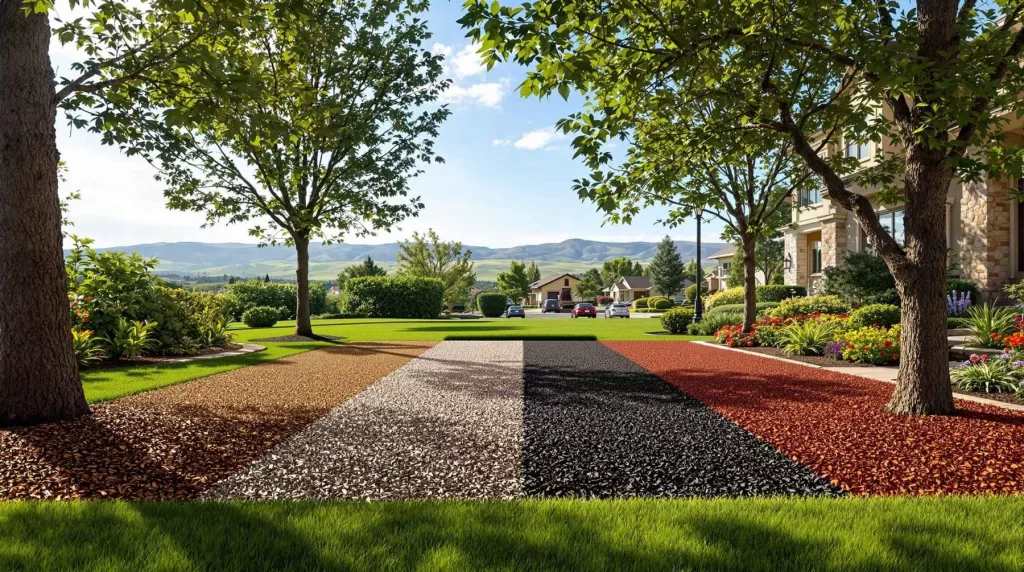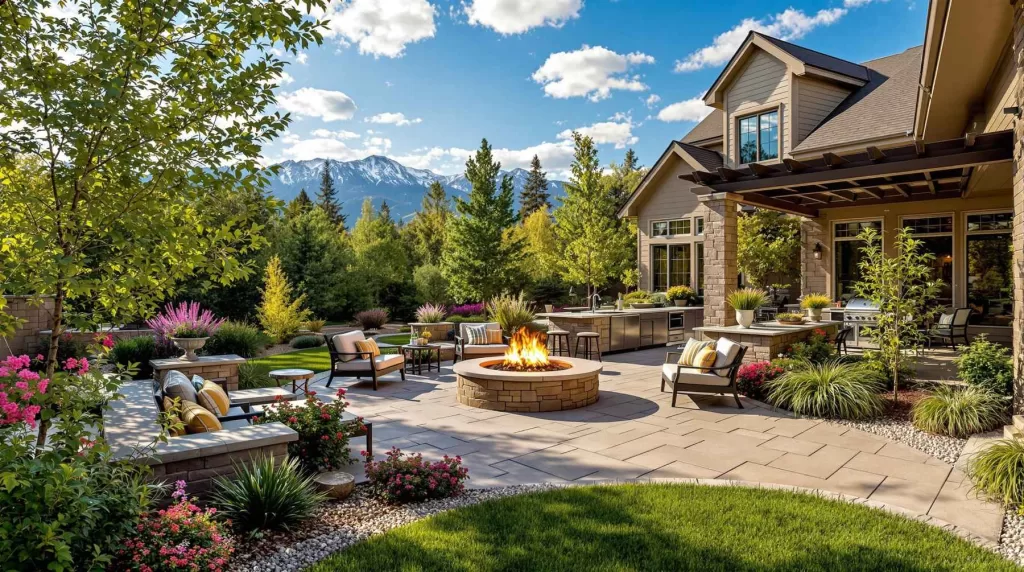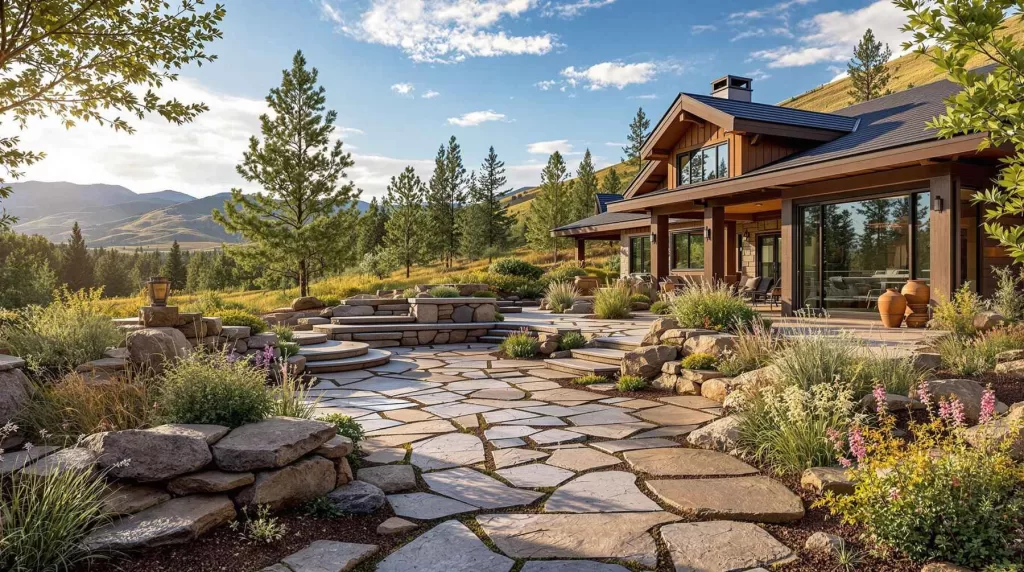Introduction
Creating a low-water landscape in Castle Pines isn’t just a trend — it’s a practical, eco-friendly solution tailored to the region’s dry climate and water restrictions. With the right planning, you can design a yard that thrives with minimal irrigation, reduces monthly water bills, and still looks absolutely stunning. This blog will guide you through the key steps and considerations to help you create a functional, beautiful, and HOA-compliant outdoor space that uses far less water than a traditional lawn.
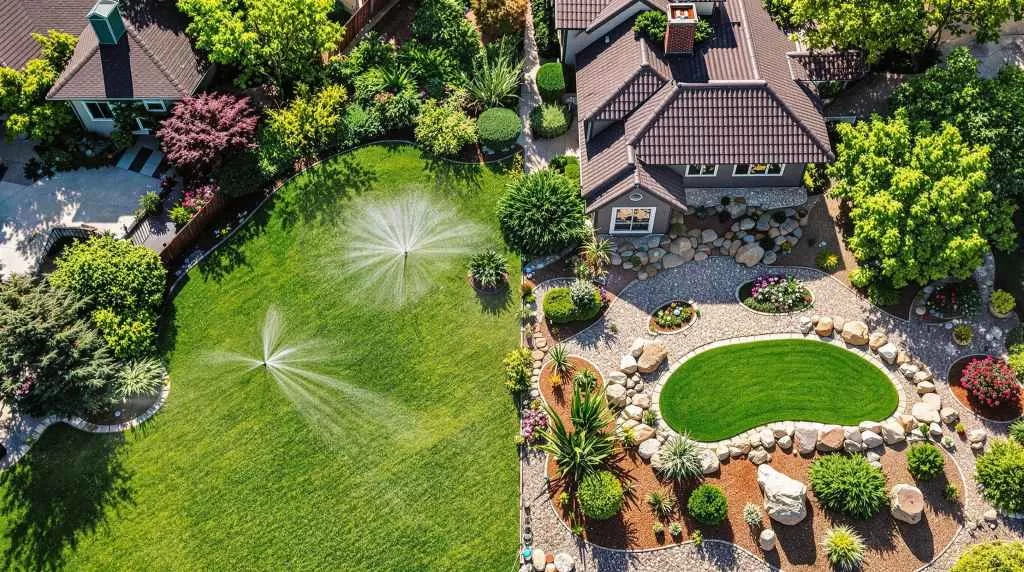
Why Low-Water Landscaping Matters in Castle Pines
The semi-arid climate and elevation of Castle Pines make water conservation a top priority for homeowners. Partnering with a knowledgeable Castle Pines landscaping contractor ensures that your outdoor space meets HOA guidelines while remaining both stylish and sustainable. From financial savings to long-term plant health, there are many compelling reasons to embrace a low-water landscape design.
Understanding Castle Pines’ Semi-Arid Climate
Castle Pines receives limited rainfall each year, with hot summers and freezing winters — making water retention and plant hardiness essential. A low-water landscape helps your yard thrive in this climate without constant irrigation or plant loss.
The Push for Water Conservation
Local HOAs and municipalities are increasingly encouraging residents to reduce outdoor water usage. Many communities are introducing water-efficient incentives and discouraging high-maintenance lawns, making drought-tolerant landscaping both a smart and compliant choice.
Benefits of a Low-Water Landscape
Low-water landscapes offer reduced utility bills, lower maintenance demands, and enhanced curb appeal. With proper planning, these designs not only conserve resources but also create beautiful, functional spaces that look great year-round.
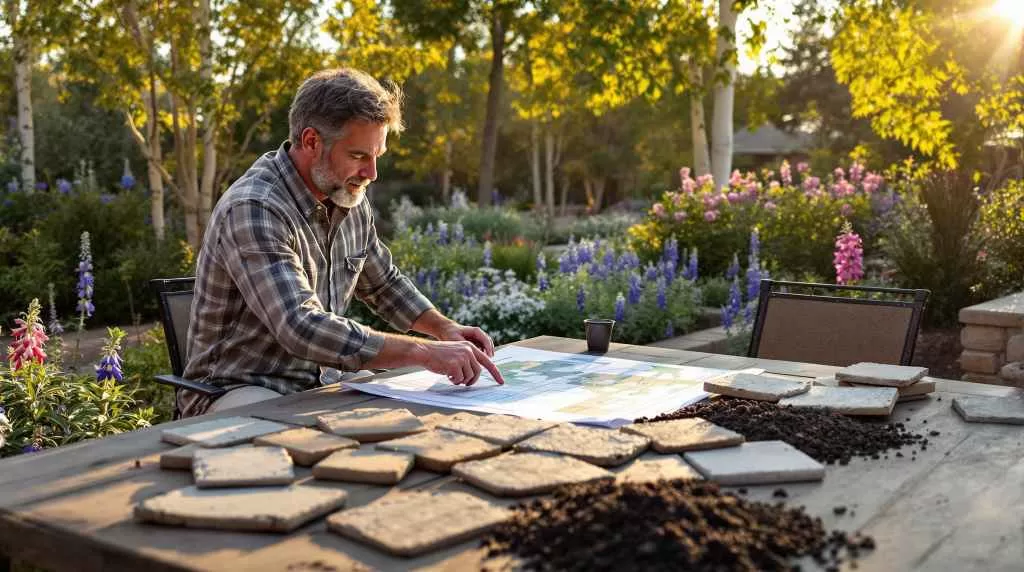
Planning Your Low-Water Landscape
A thoughtful design is the key to creating a functional and beautiful yard that uses less water. Working with professionals who specialize in custom Castle Pines landscaping can help you navigate HOA guidelines, climate conditions, and design preferences to ensure your outdoor space is both compliant and efficient.
Assessing Your Yard’s Conditions
Start by evaluating the natural conditions of your property, including sun exposure, soil type, and drainage patterns. Understanding how these factors affect water retention and plant health will help you choose the right materials and layout from the beginning.
Defining Your Landscape Goals
Before diving into plant lists or layouts, define what you want your space to achieve. Whether it’s entertaining guests, creating a play space, or simply reducing maintenance, knowing your goals will guide all your design decisions while keeping water efficiency top of mind.
Choosing a Design Style That Works in Castle Pines
Castle Pines neighborhoods typically favor polished, upscale aesthetics. Consider a design style that reflects the local architecture and HOA preferences—from modern xeriscapes with geometric hardscaping to naturalistic native gardens with flowing lines and earth tones.
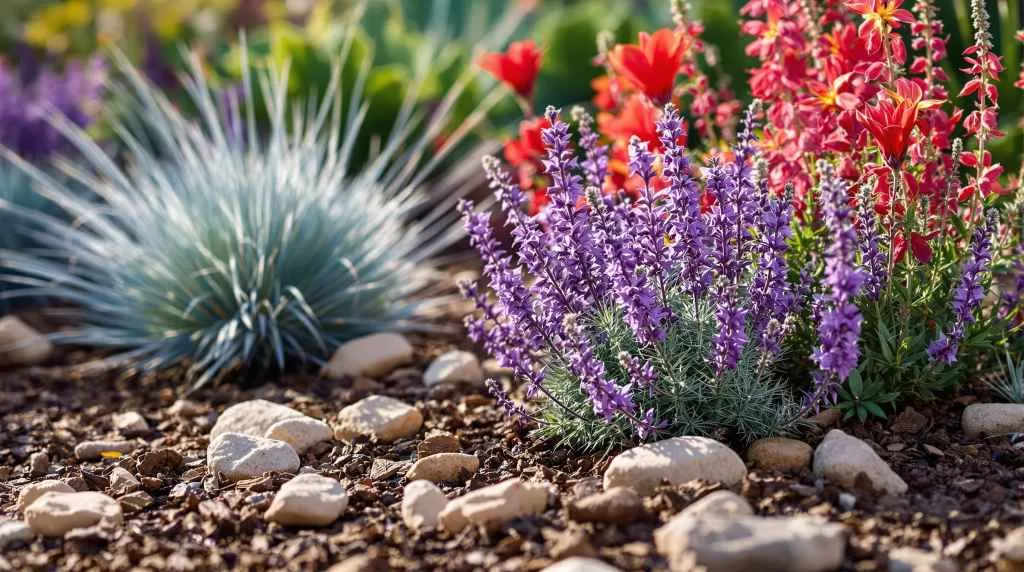
Choosing Drought-Tolerant Plants for Castle Pines
Selecting the right plant palette is one of the most impactful steps when exploring Castle Pines landscape improvement ideas. Focusing on species that naturally require less water ensures your landscape stays lush and colorful without putting stress on your irrigation system—or your budget.
Native vs. Xeriscape Plants
Native plants are already adapted to the local climate, requiring less care and water to thrive. Xeriscape plants, while not always native, are equally suited to low-water environments. Combining both gives you a diverse and resilient plant palette that feels intentional and well-balanced.
Best Trees for Low-Water Use
Opt for trees like Bur Oak, Honeylocust, or Southwestern White Pine, which offer shade and structure without demanding frequent watering. These species are well-suited to the elevation and dryness of Castle Pines and help create visual anchors throughout your yard.
Low-Water Shrubs and Perennials
Incorporate shrubs like Russian Sage, Sand Cherry, and Potentilla, which add height, texture, and seasonal color. For perennials, consider yarrow, blanket flower, and penstemon—plants that thrive with minimal watering and return year after year.
Groundcovers and Grasses
Swap out turf for low-water groundcovers like Creeping Thyme or Ice Plant, which add visual interest and fill space effectively. Ornamental grasses such as Blue Grama or Little Bluestem introduce movement and softness while standing up well to dry conditions.
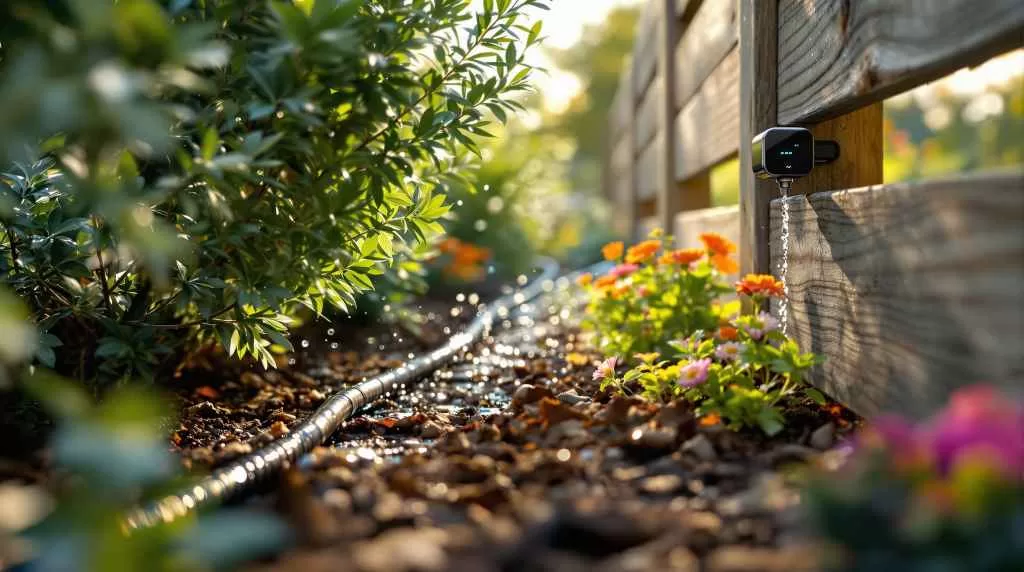
Smart Irrigation Solutions for Low-Water Yards
Efficient irrigation is essential for maintaining a healthy, low-water landscape in Castle Pines. The right system will deliver just enough water to support plant health without unnecessary waste, helping you stay compliant with local watering rules and avoid overwatering drought-tolerant species.
Drip Irrigation Systems
Drip irrigation delivers water directly to plant roots, minimizing evaporation and runoff. It’s ideal for flower beds, trees, and shrubs, and allows you to fine-tune flow rates based on individual plant needs.
Smart Controllers and Moisture Sensors
Upgrading to a smart controller paired with soil moisture sensors helps you automate watering based on real-time conditions. These systems adjust schedules based on weather, humidity, and soil saturation, ensuring optimal plant care with minimal input.
Zoning for Efficiency
Organize your irrigation into zones based on sun exposure and plant water requirements. This allows you to apply water precisely where it’s needed and avoid wasting resources on over-irrigated areas. A well-zoned system keeps your entire yard balanced and efficient.
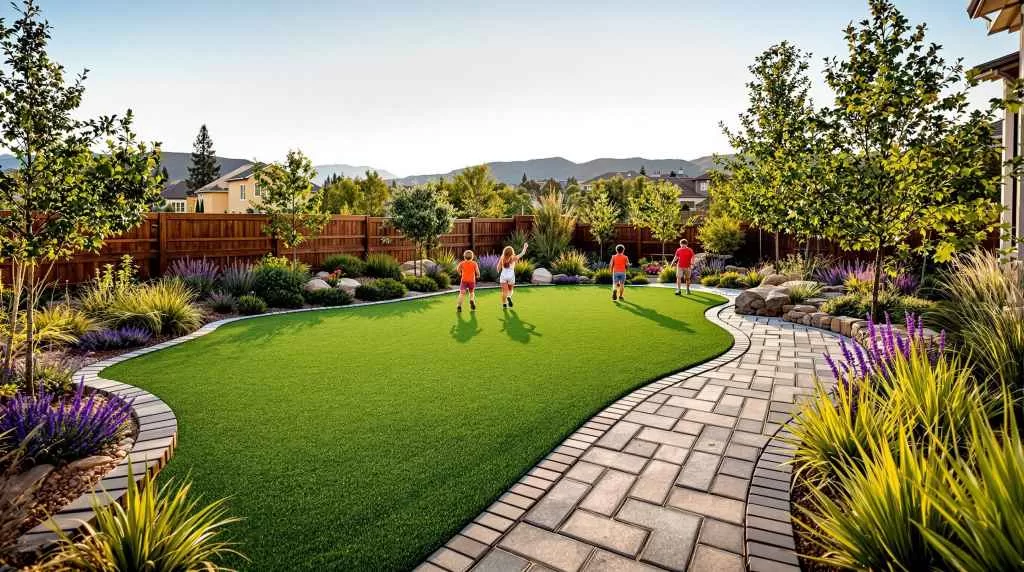
Replacing Your Lawn with Artificial Turf or Alternatives
Reducing or eliminating traditional grass is one of the most effective ways to lower your outdoor water usage. Many Castle Pines home exterior transformations now include synthetic turf, native groundcovers, or decorative rock—each offering aesthetic appeal with virtually no irrigation requirements.
Is Artificial Turf Right for You?
Artificial turf provides a clean, green look year-round without any mowing, fertilizing, or watering. It’s an excellent choice for high-traffic areas, play zones, or pet-friendly spaces, and many premium products look incredibly realistic while meeting HOA expectations.
Natural Lawn Alternatives
Low-water lawn substitutes like buffalo grass, blue grama, or eco-lawn mixes offer a soft, natural look and require far less water than traditional sod. These alternatives grow slowly, need minimal mowing, and handle Colorado’s climate exceptionally well.
Decorative Rock and Mulch as Design Features
Incorporating materials like river rock, crushed granite, or bark mulch can fill space beautifully while enhancing drainage and minimizing maintenance. These elements create natural-looking contrast and texture, especially when paired with low-water plants or dry creek beds.
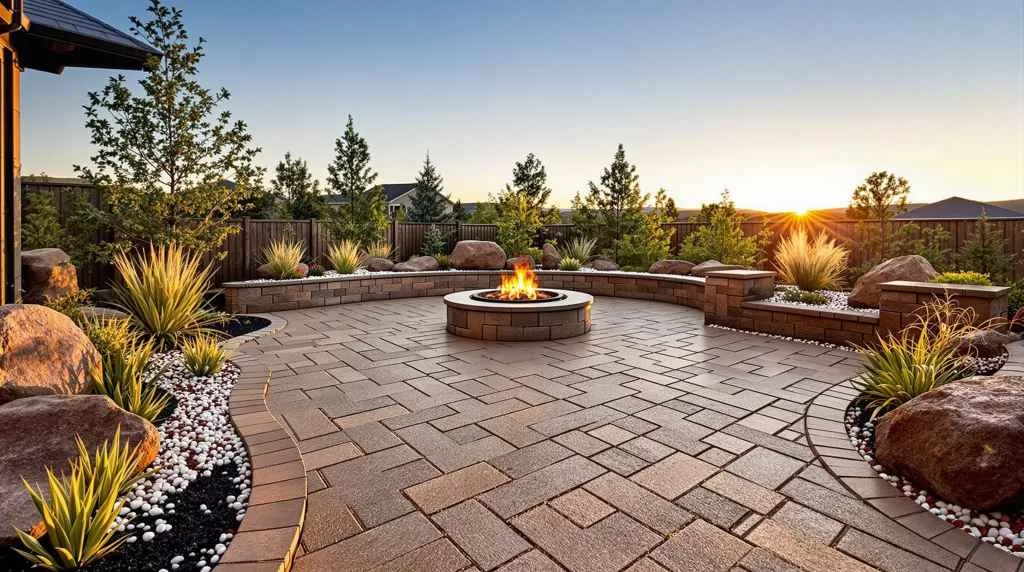
Using Hardscaping to Reduce Water Usage
Strategically adding hardscape elements to your landscape can drastically cut down on water needs while increasing functionality and beauty. Patios, pathways, and retaining walls eliminate the need for irrigation in those areas and contribute to a clean, cohesive outdoor layout.
Paver Patios and Walkways
Installing paver surfaces allows you to replace water-thirsty lawn areas with attractive, low-maintenance spaces for entertaining and movement. Pavers also come in a wide variety of styles and colors to complement your home’s architecture.
Retaining Walls and Terracing
For sloped yards, retaining walls help create level planting beds, reduce runoff, and control erosion. These structures add dimension and structure while helping plants retain more water where they’re needed most.
Outdoor Living Spaces
Designing functional areas like fire pits, grilling stations, or seating zones reduces the square footage of plantable space while enhancing your backyard’s purpose. These additions provide long-term value and allow for creative, water-wise design.
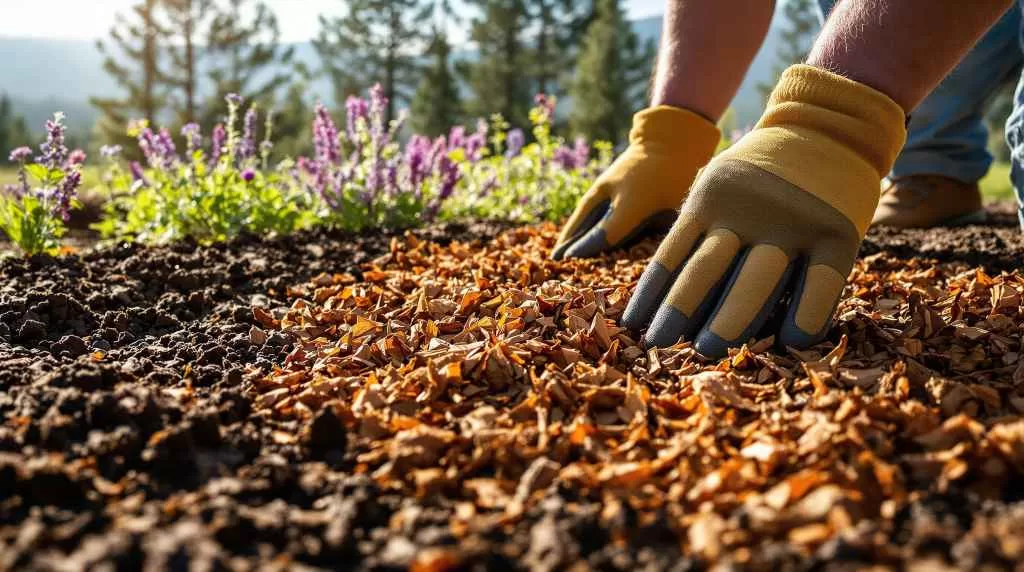
Soil Preparation and Mulching Techniques
Healthy soil and proper mulching are the foundation of a successful low-water landscape. Investing time in these early steps ensures your plants are better equipped to retain moisture, resist disease, and grow strong in Castle Pines’ dry conditions.
Amending Poor Soil
Many properties in Castle Pines have clay-heavy or rocky soil, which can restrict drainage and root development. Amending with organic compost, sand, or soil conditioners improves texture and allows for better water infiltration and retention.
The Importance of Mulching
Mulch helps regulate soil temperature, prevent erosion, and retain moisture—all of which are essential for drought-tolerant plants. Apply 2 to 3 inches of bark, wood chips, or gravel mulch around plantings to minimize evaporation and keep weeds under control.
Preventing Runoff and Erosion
In sloped areas, use terraces, contouring, or swales to slow water flow and direct it to where plants need it most. These techniques help reduce surface runoff and soil erosion, especially during heavy rain or spring snowmelt.
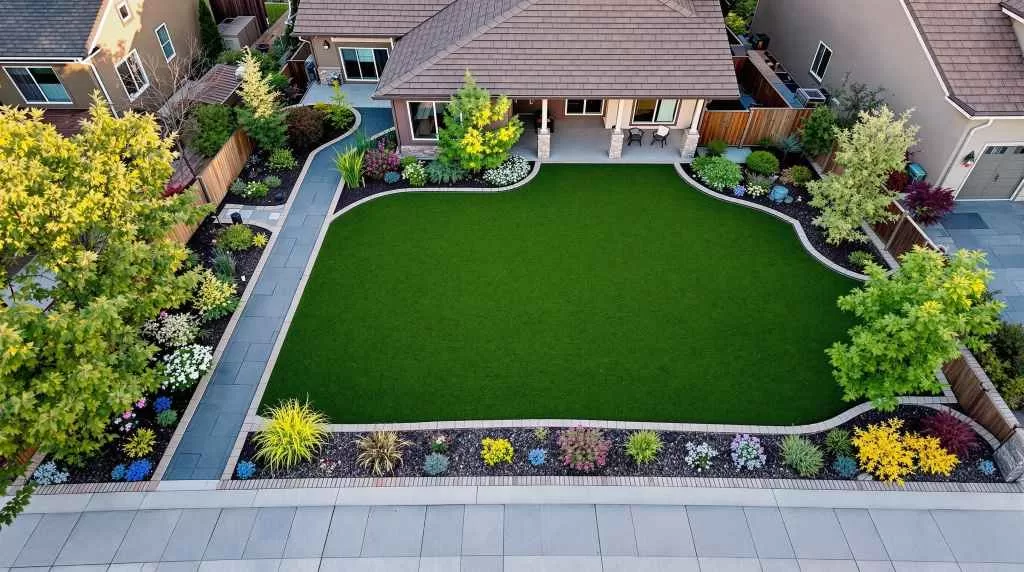
Meeting Castle Pines HOA Landscaping Guidelines
Castle Pines neighborhoods often have strict HOA landscaping standards, making it important to design your low-water yard with compliance in mind. With the right approach, you can achieve both beauty and approval without unnecessary delays or redesigns.
Understanding HOA Restrictions
Most HOAs in Castle Pines require a balanced combination of live plant material and hardscape, along with specific guidelines for turf types, plant coverage, and irrigation methods. It’s essential to review these rules early in the planning process to avoid rework.
Getting Design Approval
Before beginning installation, submit a detailed landscape plan that includes plant selections, layout drawings, and descriptions of any artificial turf or hardscape features. Clear communication with your HOA board can streamline the approval process.
Balancing Creativity and Compliance
You can still design a visually striking landscape while following HOA rules by using elevated design techniques, such as layering plants, mixing textures, and incorporating natural stone or decorative mulch. Creativity within the framework leads to standout curb appeal.
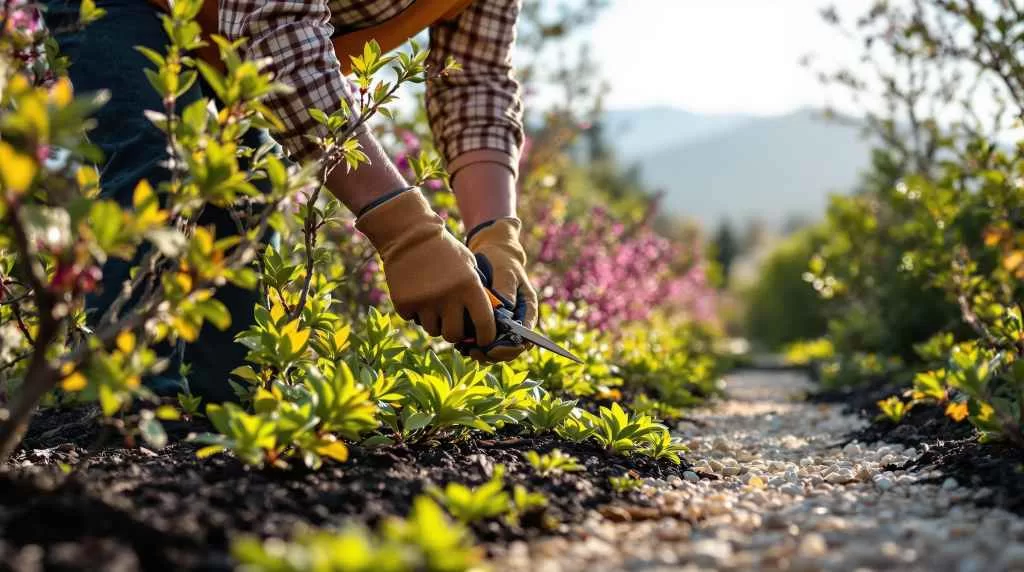
Seasonal Maintenance Tips for Low-Water Landscapes
Even drought-tolerant landscapes need a bit of care to stay healthy and beautiful throughout the year. With a few seasonal tasks, you can keep your Castle Pines yard looking fresh without increasing your water use or maintenance time.
Spring and Summer Tasks
Inspect your irrigation system for leaks or clogs, replenish mulch, and prune back dead or damaged growth. Warmer months are also a good time to check for pests and spot-weed before they spread.
Fall and Winter Preparation
As temperatures drop, it’s important to shut down and winterize irrigation systems, especially drip lines that can crack in freezing conditions. Cut back perennials, remove fallen debris, and prepare any sensitive plants for frost.
Monitoring Plant Health
Keep an eye on your plants for signs of drought stress, root rot, or insect activity. Even low-water plants can experience issues if conditions shift suddenly, so occasional walkthroughs can prevent bigger problems later.
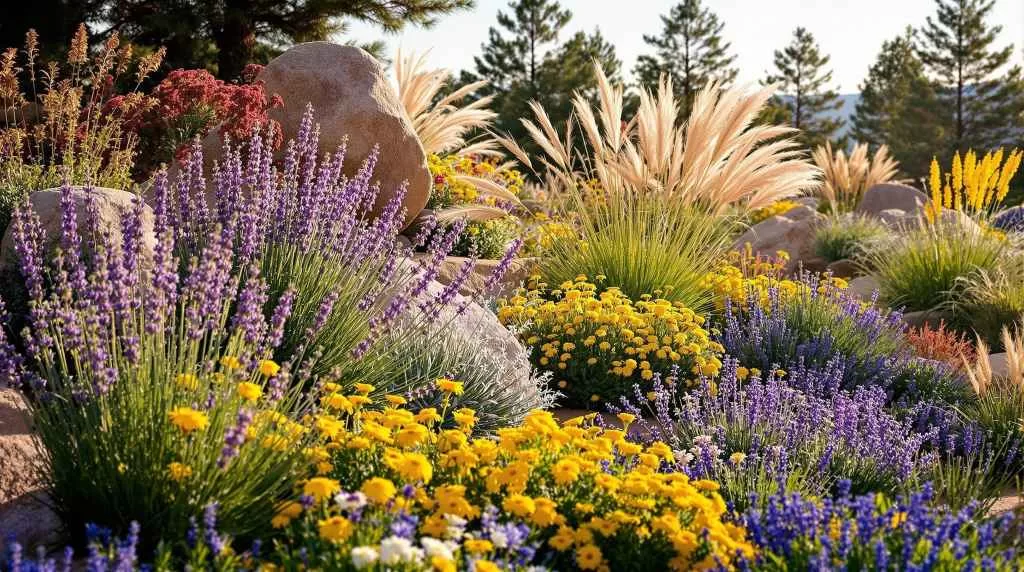
Adding Color and Texture Without Extra Water
A common misconception is that low-water landscapes are bland—but with the right choices, you can easily elevate your outdoor space in Castle Pines while staying drought-conscious. Through texture, color, and visual rhythm, your yard can look vibrant all year long without added irrigation.
Contrasting Foliage and Plant Shapes
Use a mix of leaf shapes, heights, and colors to create dimension and movement. Pair spiky yucca with soft lamb’s ear or combine fine-textured grasses with bold-leaved succulents for visual contrast.
Bloom Cycles for Seasonal Color
Select plants that bloom at different times of year to ensure ongoing color. Spring-blooming tulips, summer lavender, and fall-blooming asters create a full-season palette while keeping water use low.
Incorporating Decorative Elements
Add boulders, garden sculptures, or dry creek beds to serve as eye-catching focal points that require no watering. These elements introduce character and structure while reducing the need for plant density.

Working with a Local Landscape Designer
Bringing in a professional who understands the local environment can make all the difference in the success of your project. A skilled designer will align your vision with climate-appropriate solutions and HOA requirements while optimizing for beauty and function.
Why Local Expertise Matters
A Castle Pines Landscape Designer knows which plants perform best, how to work with elevation changes, and how to build in compliance with neighborhood standards. This local knowledge reduces costly trial and error and speeds up project approval.
What to Expect in a Landscape Design Package
A full-service design package typically includes a scaled layout, plant list, hardscape materials, lighting plans, and irrigation recommendations. You may also receive 3D renderings or mood boards to help visualize the final result.
Choosing the Right Landscape Company
Look for a company with a strong portfolio of local work, positive client reviews, and clear communication throughout the process. A trustworthy team should guide you from concept to completion with transparency and attention to detail.
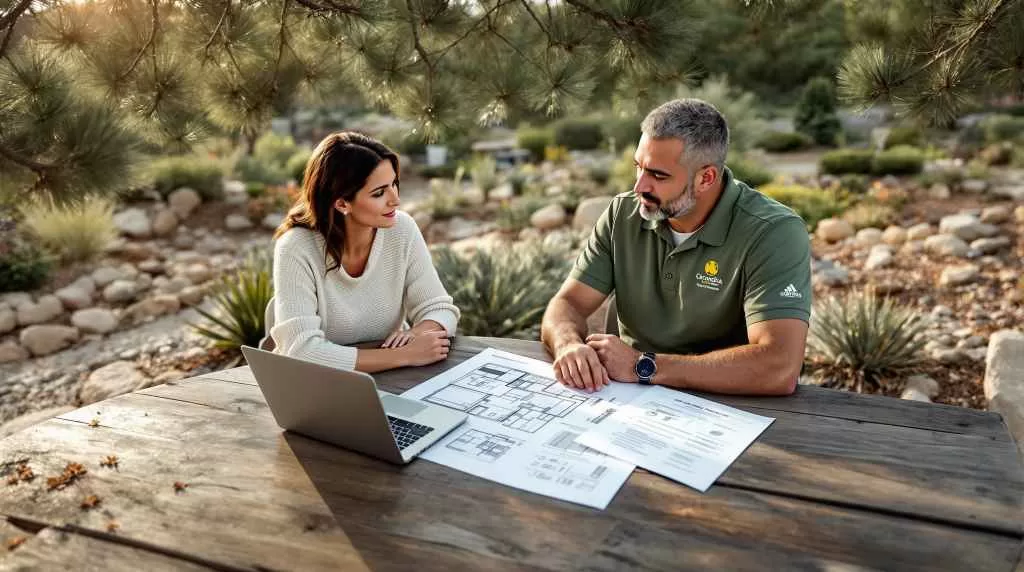
Budgeting for a Low-Water Landscape
A low-water landscape can be both affordable and luxurious, depending on your goals and materials. Planning your budget ahead of time allows you to make smart, phased investments that maximize long-term savings while achieving your desired look.
Initial Investment vs. Long-Term Savings
While the upfront cost for drought-tolerant landscapes can be higher than basic lawn installs, the ongoing savings on water, fertilizer, and maintenance often pay off within just a few years.
Breaking Down the Cost by Feature
Your final price will depend on the combination of elements you choose. Here’s a rough breakdown to help set expectations:
- Artificial turf: $20–$30 per square foot
- Drip irrigation systems: $1,000–$5,000
- Hardscaping (pavers, walls): $30–$60 per square foot
- Plant materials and mulch: $1,500–$5,000+ depending on size
Phased Installation Options
If your full vision isn’t in the budget right away, consider a phased approach—starting with hardscape and irrigation, then adding plants and turf as funds allow. This strategy helps maintain momentum while spreading costs over time.
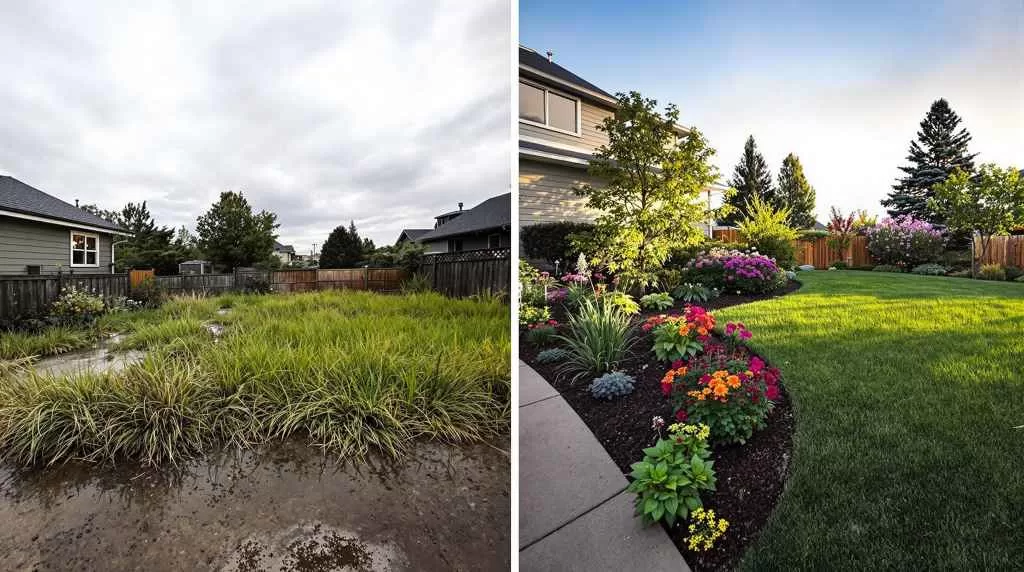
Common Mistakes to Avoid
Even with the best intentions, certain design or maintenance missteps can reduce the effectiveness of your low-water landscape. Being aware of these common mistakes will help you save money, prevent plant failure, and create a more sustainable outdoor space from day one.
Overwatering Drought-Tolerant Plants
It’s tempting to water new plants more than needed, but overwatering can stress or even kill drought-resistant species. Always follow specific watering guidelines for each plant type, especially after establishment.
Poor Plant Placement
Placing sun-loving plants in shady areas—or vice versa—leads to weak growth and poor health. Group plants with similar sunlight and water needs together to avoid confusion and promote efficiency.
Skipping Soil Prep
Installing plants without improving the soil is a fast track to failure. Amending and loosening the soil ensures roots can grow deeply, retain moisture, and withstand Castle Pines’ challenging conditions.
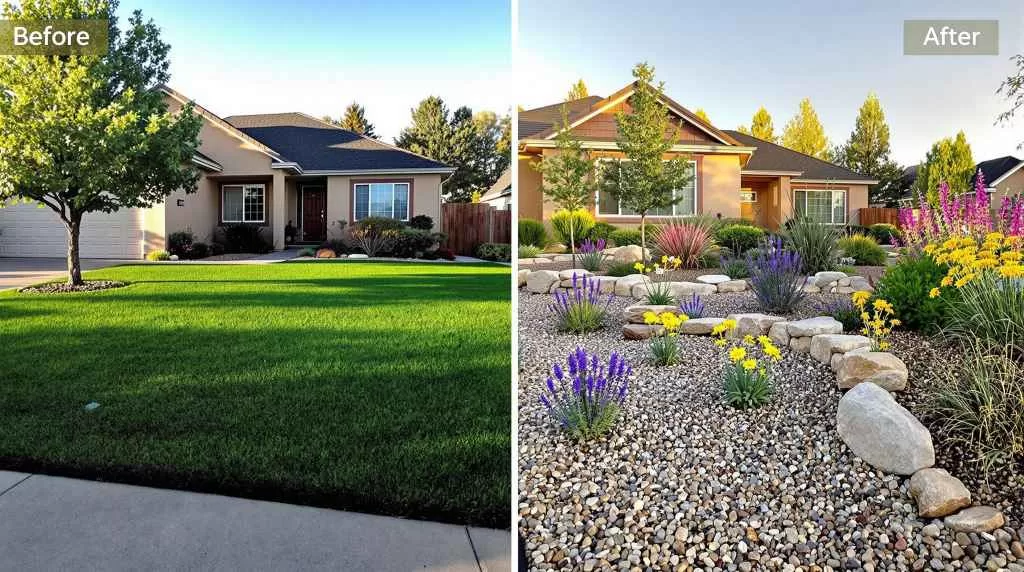
Real-Life Examples in Castle Pines
Looking for inspiration? These real-world projects offer creative solutions and stunning results that showcase how low-water landscaping can be both practical and eye-catching. Each example reflects thoughtful property upgrades in Castle Pines that meet HOA standards while dramatically reducing water usage.
Front Yard Xeriscape Makeover
This project replaced a traditional lawn with decorative rock, native grasses, and flowering perennials, resulting in a colorful and low-maintenance front yard. The layered plant design added texture and curb appeal without exceeding watering limits.
Backyard Retreat with Artificial Turf and Fire Pit
In this transformation, a patchy lawn was replaced with premium artificial turf, paver walkways, and a cozy built-in fire pit. The new layout created space for entertaining while eliminating the need for irrigation.
Sloped Yard Solution Using Retaining Walls and Groundcovers
A challenging hillside was reshaped with tiered retaining walls and drought-tolerant groundcovers like creeping thyme and ice plant. The finished landscape controlled erosion and created usable planting areas with vibrant, water-wise textures.
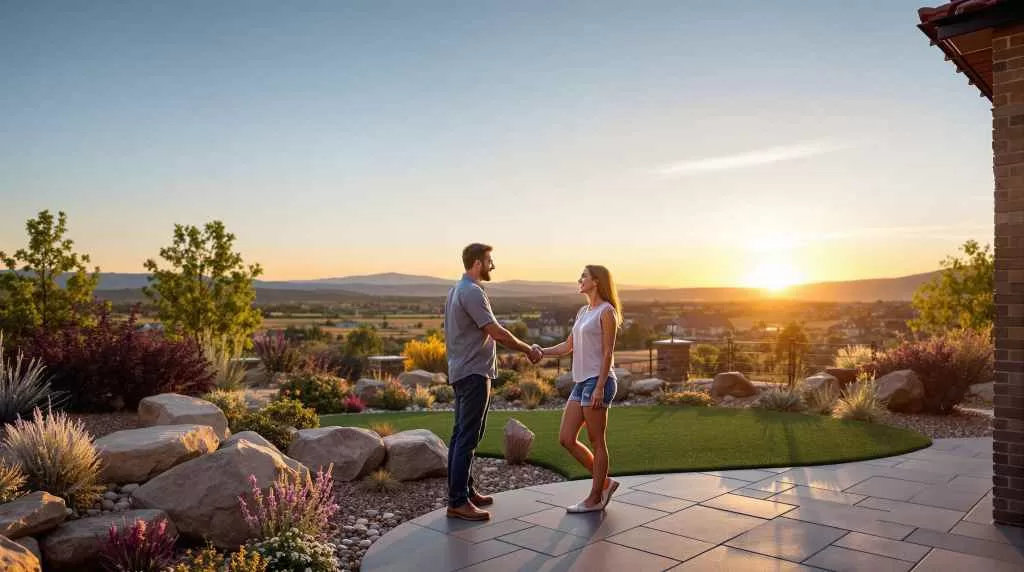
Ready to Transform Your Outdoor Space?
If you’re ready to bring beauty, efficiency, and long-term value to your Castle Pines home, our team is here to help. From front yard xeriscaping to full backyard overhauls, we specialize in custom low-water landscapes designed to thrive in Colorado’s unique climate. We proudly serve Castle Pines and surrounding areas like Castle Rock, Parker, and Lone Tree. Let’s create a landscape you’ll love—and that lasts. Reach out today to schedule your consultation and take the first step toward a more sustainable, stunning outdoor space.

